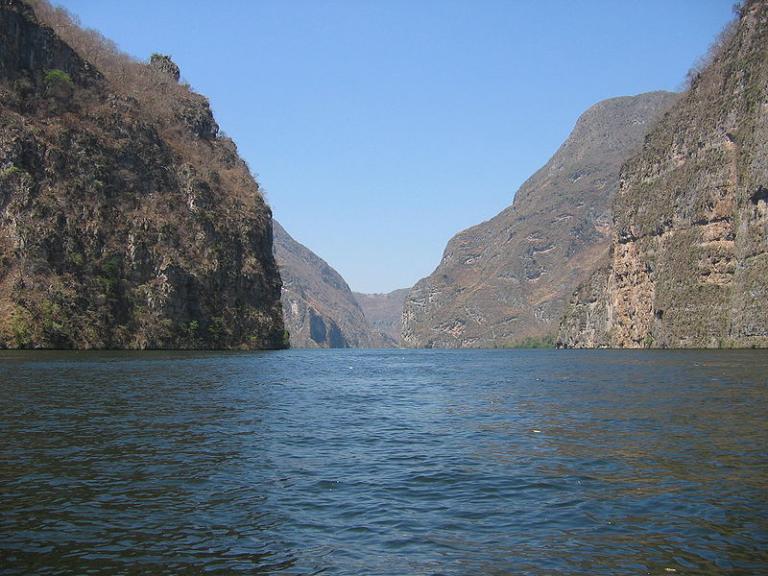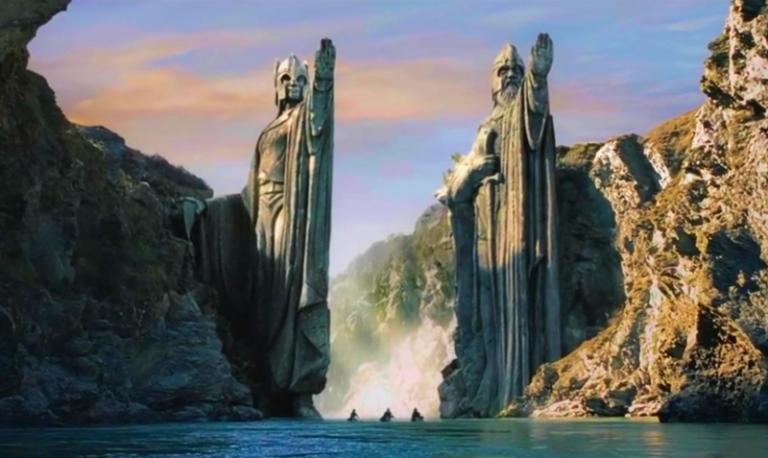
(Wikimedia Commons public domain image)
I’m going to make a serious effort to catch up on my reporting from this Interpreter Foundation educational tour in Guatemala and Mexico. I’m several days behind because of the mysterious computer malfunction that crippled me from Wednesday night until last night, Monday night. But I think that I can compensate for that, more or less.
We arrived on Sunday night in Tapachula, a city that is located in the far southeast of the state of Chiapas, México, near the Pacific Ocean and the Guatemalan border, and that several scholars have suggested as a likely candidate for the land of Lehi’s “first inheritance.” On Monday morning, we spent some time at two locations within the archaeological site of Izapa, which is famous among Latter-day Saints (at least of my generation) for its “Izapa Stela 5,” the so-called “Tree of Life stone” that some (starting with the late M. Wells Jakeman and continuing with, among others, the late V. Garth Norman) have identified with Lehi’s vision in 1 Nephi 8. (Other equally faithful Latter-day Saint authorities vigorously challenge that identification, although it seems that there is consensus agreement on its being some sort of representation of “the tree of life.”). It dates to about 300 BC.

We drove along the Pacific coast and actually stopped to stick a few toes in the ocean. It is likely that Lehi and his party made landfall somewhat further to the south, in what is now Guatemala, but along a coastline very much like the one that we saw. This is the area of what Blake Allen (our tour operator and overall guide) and his late father, Joseph Allen, believe to be the location of the famous “day and a half’s journey”:
And now, it was only the distance of a day and a half’s journey for a Nephite, on the line Bountiful and the land Desolation, from the east to the west sea; and thus the land of Nephi and the land of Zarahemla were nearly surrounded by water, there being a small neck of land between the land northward and the land southward. (Alma 22:32)
It is also the area of the infamous city of Ammonihah. We were traveling to the valley or depression of Chiapas, which has been proposed as the Land of Zarahemla and which was the heartland of the Nephites for more than half a millennium, commencing about two centuries before Christ:
13 And it came to pass that he did according as the Lord had commanded him. And they departed out of the land into the wilderness, as many as would hearken unto the voice of the Lord; and they were led by many preachings and prophesyings. And they were admonished continually by the word of God; and they were led by the power of his arm, through the wilderness until they came down into the land which is called the land of Zarahemla.
14 And they discovered a people, who were called the people of Zarahemla. Now, there was great rejoicing among the people of Zarahemla; and also Zarahemla did rejoice exceedingly, because the Lord had sent the people of Mosiah with the plates of brass, which contained the record of the Jews.
15 Behold, it came to pass that Mosiah discovered that the people of Zarahemla came out from Jerusalem at the time that Zedekiah, king of Judah, was carried away captive into Babylon. (Omni 1:13-15)
In the middle of the fourth century after Christ, just a few decades before the final collapse of Nephite civilization and the Nephite polity, things changed:
28 And the three hundred and forty and ninth year had passed away. And in the three hundred and fiftieth year we made a treaty with the Lamanites and the robbers of Gadianton, in which we did get the lands of our inheritance divided.
29 And the Lamanites did give unto us the land northward, yea, even to the narrow passage which led into the land southward. And we did give unto the Lamanites all the land southward. (Mormon 2:28-29)
We spent last evening in Tuxtla Gutiérrez, the capital of Chiapas. Starting fairly early this morning, though, we headed out to Chiapa de Corzo, which various Mesoamericanist students of the Book of Mormon have proposed as the site of the Nephite city of Sidom.
1 And it came to pass that Alma and Amulek were commanded to depart out of that city; and they departed, and came out even into the land of Sidom; and behold, there they found all the people who had departed out of the land of Ammonihah, who had been cast out and stoned, because they believed in the words of Alma.
2 And they related unto them all that had happened unto their wives and children, and also concerning themselves, and of their power of deliverance.
3 And also Zeezrom lay sick at Sidom, with a burning fever, which was caused by the great tribulations of his mind on account of his wickedness, for he supposed that Alma and Amulek were no more; and he supposed that they had been slain because of his iniquity. And this great sin, and his many other sins, did harrow up his mind until it did become exceedingly sore, having no deliverance; therefore he began to be scorched with a burning heat.
4 Now, when he heard that Alma and Amulek were in the land of Sidom, his heart began to take courage; and he sent a message immediately unto them, desiring them to come unto him.
5 And it came to pass that they went immediately, obeying the message which he had sent unto them; and they went in unto the house unto Zeezrom; and they found him upon his bed, sick, being very low with a burning fever; and his mind also was exceedingly sore because of his iniquities; and when he saw them he stretched forth his hand, and besought them that they would heal him.
6 And it came to pass that Alma said unto him, taking him by the hand: Believest thou in the power of Christ unto salvation?
7 And he answered and said: Yea, I believe all the words that thou hast taught.
8 And Alma said: If thou believest in the redemption of Christ thou canst be healed.
It’s a comparatively simple site, which is appropriate. Why? Brant Gardner, who is along with us as an Interpreter Mesoamerican expert, quipped onsite today that, for many years, the Latter-day Saint rule for distinguishing purportedly Nephite archaeological ruins from purportedly Lamanite ruins boiled down to this principle: Beautiful or spectacular ruins were Nephite, while ugly or unimpressive sites were Lamanite. But this, he suggested, is probably the exact opposite of the truth. Any archaeological ruins left behind by the relatively simple, unstratified, and aniconic Nephite civilization would likely be far less spectacular than those remaining from the idolatrous Lamanites. And he pointed around us to the restrained monuments remaining from Chiapa de Corzo (Sidom?) as an illustration of that difference.

After Chiapa de Corzo, we spent approximately two hours on a boat cruising along the Rio Grijalva, which John Sorenson and (I think) most contemporary adherents to Mesoamerican models of Book of Mormon geography identify with the Nephites’ vitally important River Sidon. It was a very pleasant boat ride through the spectacular Sumidero Canyon, which forcibly brings to mind the River Anduin at the northern border of Gondor in Lord of the Rings. I almost expected to see the enormous stone figures of the kings Isildur and Anárion standing on either side of the river at the Gates of Argonath with hands upraised in warning. (I wasn’t the only person who thought of that image; at least two others mentioned it to me.)

We saw innumerable white herons and gray herons and pelicans and other waterfowl, we watched a juvenile crocodile haul itself out of the water and onto the river’s bank, and we observed two spider monkeys cavorting in trees right beside the river. We did not, however, notice any mechanical hippopotami wiggling their ears in artificial irritation. The driver of our boat didn’t fire his pistol to frighten any such hippopotami away. Nor did we pass behind Schweitzer Falls in order to see the other side of water. Nor did we encounter a shrunken-head salesman offering two of his for one of ours.
The limestone cliffs of Sumidero Canyon rise up several thousand feet on either side of the Grijalva. They reminded me of the sheer vertical cliffs that loom over Lauterbrunnen, in Switzerland’s Berner Oberland. But the latter, of course, were carved out by glaciation, whereas Sumidero appears to have been created by the Grijalva.

After lunch back in Tuxtla Gutiérrez, we drove – partly along the Grijalva — to Villahermosa, the capital and largest city of the state of Tabasco (which, to my surprise, apparently has no connection with the famous sauce). We’re spending tonight and tomorrow night in Villahermosa. According to a number of folks who have studied the matter, the city likely represents the western edge of “the land among many waters” that is described in Mosiah 8:8:
And they were lost in the wilderness for the space of many days, yet they were diligent, and found not the land of Zarahemla but returned to this land, having traveled in a land among many waters, having discovered a land which was covered with bones of men, and of beasts, and was also covered with ruins of buildings of every kind, having discovered a land which had been peopled with a people who were as numerous as the hosts of Israel.
Posted from Villahermosa, Tabasco, México












